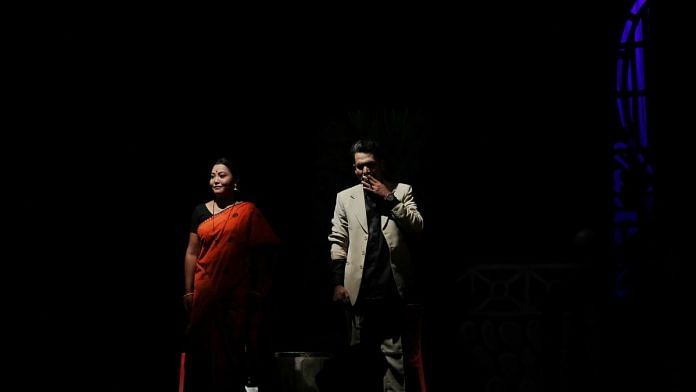Hundreds stare at the stage, solemn and rapt, as the schoolteacher they’ve all been rooting for points her gun and pulls the trigger on her husband. His crime? Aiding a corrupt politician.
What makes this cathartic scene of comeuppance in the Assamese play Agni Kanya rather piquant in this September staging is the front-row presence of Assam Chief Minister Himanta Biswa Sarma.
Assamese mobile theatre, or ‘Bhramyaman’, is all about testing boundaries, taking risks, and highlighting social issues in an entertaining way, which is what audiences love about it. In the era of OTT, smartphones and YouTube addiction, the continuing popularity of theatre in Assam is counter-intuitive. The themes and content keep changing, but its appeal is timeless. How it seamlessly balances continuity with experimentation is key to its appeal.
Every mobile theatre season—from late August to April—sees troupes and their equipment travel across the state to local communities, with a repertoire of new plays. Unmediated by screens or elitist pretensions, the shows are not just spectacles of melodrama, music, dance, and special effects but also social events that draw energy from audiences and channel it back to them.
In an era where dragging teenagers off their couches is a task, and smartphones with high-speed internet are an extension of their bodies, Rajtilak Theatre’s staging of the social-political drama Mahishasur in Nalbari has seen a staggering number of youngsters.
A few kilometres away in Guwahati’s Gopal Boro grounds, the audience claps to Awahan Theatre’s Moi Natok Kora Suali, a play about an actor’s quest to find out about her biological father.

Perhaps this is why Bhramyaman has survived for over 40 years and thrived despite the onslaught of multiplexes and OTT platforms. Even now, several production houses vie to outdo each other. The biggest stars reportedly earn anything from Rs 20 lakh to Rs 50 lakh in a season, and audiences happily shell out anything between Rs 75 to Rs 1,000 for a seat. The average yearly collections amount to Rs 25 crore.
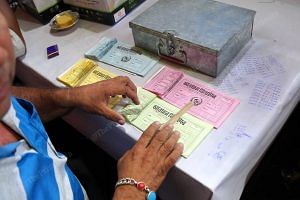
While a two-year hiatus due to Covid-19 dealt a near-death blow to mobile theatre, this year’s season is in full tilt. Trucks piled with equipment and crew are trundling into villages, loudspeakers are once again announcing latest plays, colourful posters and hoardings have appeared on streets, and shows run houseful day after day, night after night.
Also read: Prastuti Porasor is Assam’s one-woman cultural powerhouse and a ‘hero’ for 2 decades now
Love stories, true crime, social dramas
In the last dregs of Assam’s autumn, despite an onslaught of mosquitoes, Nalbari residents are packed tightly into rows of plastic seats under a large tent, reacting to every moment unfolding in the collapsible dual-stage, which allows the characters to move seamlessly from one setting to another.
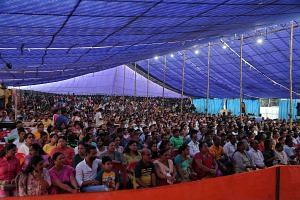
“I won’t ruin my daughter’s life by letting her marry a guy like Rishabh,” thunders a policewoman in Mahishasur, refusing to be cowed down by the clout of a local MLA. The crowd cheers wildly.
“I have been watching plays since I was a kid. After two years of Covid, it feels good to have this experience again,” says retired police officer Murlidhar Deka, who is here to watch the play with his wife.
Further along the row, two 16-year-old girls, Riya and Tanya, have accompanied their mothers to the show. “I think it is really cool that this has been around for 40 years and exists nowhere else. I am not a regular, but it is fun to watch a few plays,” says Riya.
Like the last few seasons, this one too has been dominated by plays with emotional depth, complex plotlines, and sweeping character arcs.
Take, for instance, Awahan Theatre’s 2019 hit, Madhuri Mur Naam, which traces the journey of a carefree, short-haired, jeans-wearing girl and her evolution into a mother after she chances upon an abandoned baby. There are songs, dances, and action sequences, but the real thrill comes from actor Prostuti Porasar’s portrayal of the character’s transformation. By the end, she has long hair, a penchant for saris, and seems like a different person altogether.
Then there is Bordosoila Theatre’s true crime-inspired Fasi Kathot Rajkhowa. It tells the story of sessions court judge Upendra Nath Rajkhowa, who murdered his wife and three daughters in his Dhubri bungalow—a crime for which he was hanged in 1976. While the real Rajkhowa never revealed his motives, the play uses its creative liberty to provide answers to an ever-eager audience.
Mahadev (Bordosoila Theatre, 2022-23), another ambitious tale of love and betrayal with a mythological spin. It tries to draw parallels between the characteristics of the protagonist—played by veteran actor Tapan Das—and Lord Shiva.
Agni Kanya (Awahan Theatre, 2022-2023) also experiments with narrative structure. It uses flashbacks to tell the story of a schoolteacher locked in a mental institution after killing her husband.
“There have always been phases in mobile theatre,” says Champak Sharma, a playwright and actor who has been a Bhramyaman mainstay since 1997 and is currently starring in Rajtilak Theatre’s Gangajal, a musical drama about a fisherwoman’s struggle to make ends meet.
“In the 1990s, the proliferation of movie actors [in theatre] brought Bollywood-like plays with songs and dances. But now, people want actual drama again, more stories and content,” says Sharma.
Whatever the trends of a season might be, some ingredients remain constant.
Also read:
Sound, sets, and lots of sweat
Mobile theatre may seem like magic on stage, but it hinges on the technical mastery of sound, light, and the rapid execution of set changes to achieve an illusion of seamlessness.
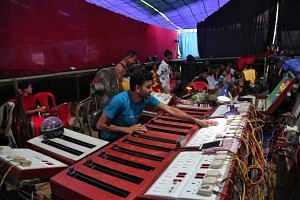
Including artists, masons, and musicians, each theatre group has about 120 members. Production costs can easily run into crores, especially if an in-demand actor is performing. But these groups don’t solely rely on the pull of their lead actors—all team members play a crucial role in making the play a success.
“Without the perfect combination of dialogue, acting, light, and sound, a play in mobile theatre cannot be successful,” says light technician Sushanta Hazarika who works with a team of seven boys. He handles the switchboard while his team manages the lights.
“We have to work in tandem with songs, dialogues and dances to make a play work. The whole khel (game) is timing,” he adds. Hazarika started with Nandini Theatre 16 years ago and now works with Awahan.
With 25 years of experience under his belt, Hitesh Chaudhary is the main mistri (carpenter) at Awahan Theatre. His job is to ensure that the stage is sturdy and that the sets, which are critical for ambience, are executed to perfection. The stage setting often changes after every three-four minutes.
“We have to know every dialogue so that the set/stage changes are smooth,” says Chaudhary.
Then there are the songs—almost every play has several. Music director Ajoy Phukan says that he doesn’t get to sleep ahead of the season, sometimes for a month or more. “We often have to create 60-80 songs for every season,” he says.
Sound effects are critical, too. From punches and kicks in action sequences to the right music pitch for emotional moments, sound design can make or break a scene.
Such elements must be perfectly in sync with the events onstage, but most technicians hold no formal training.
“I learnt sound engineering on my own. In fact, most of us technicians have all learnt after being associated with theatre. There is no formal training as such,” says Akhil Barman of Kohinoor Theatre. He is especially proud of his work for Titanic, a superhit Assamese stage adaptation of its Oscar-winning Hollywood namesake.
“I had to put in special microphones to ensure that the impact of the breaking of the ship seemed powerful enough,” he says.
Even actors go the extra mile to make their performances impactful. Many do their own makeup and could probably break a few records for changing costumes at lightning speed. But the extensive travel and multiple performances do take their toll.
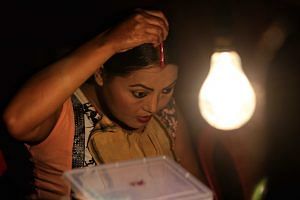
“It can be extremely taxing to travel every four days, even to remote places where camps don’t have the best facilities,” says 34-year-old actor Moon Saikia, who has been performing in Bhramyaman productions since she was 17. “We do it because we love entertaining our audience.”
Also read:
Theatre attracting youth
The ‘season’ for every theatre group lasts about nine months, beginning in Bhado (late August), and preceded by rigorous rehearsals for a month.
For many performers, the benefits—including good pay packages for established actors—outweigh the many drawbacks that can come with an unconventional profession like mobile theatre. In Assam, some youngsters now want to join theatre instead of film because of the assurance of regular employment and the guaranteed presence of a dedicated viewer base.
Jaffy Bakshi, a thespian who has also worked in films and TV, says he has found his home in mobile theatre, where he generally plays lead roles. He says the pay is better, and the audience’s immediate feedback is fulfilling.
“I started out by acting in Assamese CDs, then films, and even a TV serial. I joined mobile theatre in 2009 and there has been no looking back,” adds Jaffy.
Also read:
A social space
At most mobile theatre shows, there are no empty seats. Paan and cotton candy sellers do brisk business, and people often climb fences and line the edges of the audience arena to catch a glimpse of the action.

The gallery, or the last and cheapest row of seats, is the most lively of spaces, even serving as a source of inspiration for writers.
“I often watch plays from the gallery and listen to audience discussions and comments. That helps me write plays that will resonate,” says playwright Abhijit Bhattacharya, who works exclusively with Awahan and is known as a hit-maker.
Retired schoolteacher Nonikanta Das says some of his fondest memories growing up are from when Bhramyaman Theatre visited his village in Nagaon. He and his friends could never afford to watch their plays—not even from the gallery. However, they managed to enjoy them by peeping in from the far ends of the enclosure.
“It was about a community coming together to watch a play that was at once social and also entertaining. Unlike ‘Bhaona’ [Traditional Assamese theatre based on mythical characters], they did not represent religious views. It was a community-building /strengthening form of entertainment,” Das says.

Another loyal fan, Rishi Thakuria, remembers his days as a student of Guwahati’s Cotton College during the 2000s when he and his friends would pile into a local bus to catch matinee shows in Ganeshguri.
“We used to buy Champak Sharma’s play tickets in bulk and save our meagre pocket money for it,” says Thakuria. They picked mornings, he says, because it seemed safer for women and did not clash with hostel timings.
Even today, people buy special season tickets or passes, which are sold for around Rs 1,000 to watch plays from their favourite repertories.
Also read:
Global entertainment for local residents
One of the most important services that mobile theatre has done for Assam has been to bring the world to its remote pockets and villages by adapting international films, stories and plays to local sensibilities.
From William Shakespeare’s Hamlet and Othello to British classics like The Mayor of Casterbridge and Dr Jekyll and Mr Hyde, mobile theatre has given many Assamese people access to literature and entertainment from around the globe.
While the tradition of travelling theatre in Assam has older roots, Brahmayaman, in its current form, started taking off in the 1980s. One of its foremost proponents was Kohinoor, a major theatre repertory founded by the late Ratan Lahkar in the 1970s.
“I started with Ratan Lahkar, worked with him, and all we had was a vision and conviction. We did not know how that would actually turn out,” says Krishna Roy, who founded Awahan Theatre in 1980. A more significant aspect of this vision was to bring theatre to rural Assam.

Also read:
Theatre for the masses
Several parallels can be drawn between Bhramyaman and the evolution of 16th-century London’s theatre scene on the margins of Shoreditch, where popular playhouses, reviled by the city’s upper crust, thrived.
Assam followed a similar path. Mobile theatre’s audience has always comprised of villagers and not the elite. Even the team behind these plays—from actors to stage managers—is almost entirely drawn from disadvantaged sects. It is this focus on the entertainment of the ‘poor’ that eventually translated into popular and populist plays in both instances. These plays have become agents of creativity, dissent, and technical superiority, and Assam is all here for it.
In 1983, Kohinoor’s staging of Mahendra Barthakur’s Soraguri Sapori came as a critical intervention in the wake of the Nellie massacre, which claimed 1,800 Muslim lives. Narrating the story of the Sufi saint Azan Fakir, it served as a reminder of the syncretic nature of Assamese culture. Azan Fakir has followers across religions in Assam and is considered at par with Srimanta Sankardev, one of the state’s most revered spiritual and cultural icons.
Through such plays, mobile theatre became an instrument for sewing together the fraying fragments of Assamese society. But the flavour started to change with liberalisation and globalisation.
The 1990s and early 2000s saw more commercial experimentation. With plays like Hijack, which was based on the 1999 hijacking of Indian Airlines Flight 814, Osama bin Laden (2002), Lady Diana (2003), and Jurassic Park (2003), current events and international entertainment took centre stage in Assamese theatre. But the play most fondly remembered and admired is an adaptation of Titanic (2002), which caused an unprecedented flow to theatres.
“I was probably just 8 years old when I saw Titanic, but I can still vividly recall clapping at every other scene and how that night my family could not stop talking about the technical marvel of the play,” says Kamal Dutta, an engineer, while reminiscing the ‘ship’—mounted on a track so that it could sail on cardboard ‘waves’.
(Edited by Zoya Bhatti)


